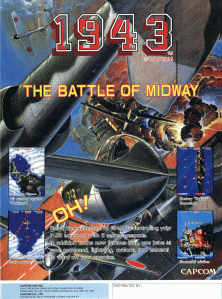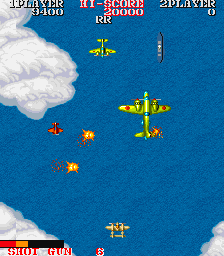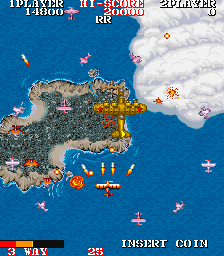1943
Topic: Software
 From HandWiki - Reading time: 7 min
From HandWiki - Reading time: 7 min
| 1943: The Battle of Midway | |
|---|---|
 North American arcade flyer | |
| Developer(s) | Capcom |
| Publisher(s) | Capcom |
| Designer(s) | Yoshiki Okamoto |
| Composer(s) | Original release: Kumi Yamaga 1943 Kai: Manami Matsumae Takashi Tateishi Junko Tamiya Hiroshige Tonomura Tamayo Kawamoto Harumi Fujita |
| Platform(s) | Arcade, NES, PC Engine, Xbox, PlayStation 2, PlayStation, Saturn, PlayStation Portable, Xbox 360, Xbox One, Atari ST, ZX Spectrum, Amstrad CPC, Commodore 64, Amiga, PlayStation 3 |
| Release | June 1987 (Arcade) |
| Genre(s) | Scrolling shooter |
| Mode(s) | Single-player, multiplayer |
| Arcade system | Capcom Commando Hardware |
1943: The Battle of Midway[lower-alpha 1] is a 1987 vertically scrolling shooter arcade video game developed and published by Capcom.[1]
It was the first follow-up to Capcom's earlier 1942. Like 1942, despite the game being created by Japanese developers, it has the player-controlled Americans attacking the Japanese air fleet; this was due to being one of the first Capcom games designed with Western markets in mind. The game's name is a reference to the Battle of Midway, which occurred in June 1942.
Gameplay
The game is set in the Pacific theater of World War II, off the coast of the Midway Atoll with the Imperial Japanese Armed Forces as the main group of antagonists. The player takes the role of an unnamed United States Air Forces ace pilot seeking revenge to defeat the Japanese air forces that attacked the American aircraft carrier, destroy all Japanese air and sea forces, fly through the 16 stages of play, and ultimately destroy the battleship Yamato, the game's final boss. 11 of these stages consist of an air-to-sea battle with a battleship or an aircraft carrier as the stage boss, while 5 stages consist of an all-aerial battle, either against a squadron of multiple strategic bombers or a single heavy bomber, the latter requires the player to shoot its engines to destroy it.
As in 1942, players pilot a P-38 Lightning. Controls are also similar: button 1 fires main weapons, and button 2 performs two special actions: one of three special lightning attacks in exchange for some of the player's fuel, or a loop maneuver like in 1942 if buttons 1 and 2 are pressed simultaneously. Indeed, players now have only one life, in the form of a large "fuel" meter; constantly depleting, but refillable by collecting various powerups. In 2-player mode, when both players overlap their planes on screen, the energy bar can be transferred from the player with more fuel to the player with less. Destroying a complete formation of red enemy planes will result in a power-up, such as a health boost or a new main weapon.
There are cheat codes, different for every stage, ranging from holding down a fire button or pointing the joystick in a certain direction; player(s) are rewarded with fully upgraded weapons.
Attacks and Items
There are a number of different weapons, attacks, and items the player can use in total.
Weapons
There are 6 different weapons in the game. The player comes equipped with a standard weapon at all times unless a power up is obtained by destroying a group of red planes, in which case the player will have a chance to receive a special weapon. The power up can also be cycled to various weapons by shooting it. Weapons include:
- Standard Machine Gun: The player comes first equipped with this. Firing two shots simultaneously when the fire button is pressed.
- Shotgun: Shoots a wide, short-ranged, shot of bullets. These bullets can also destroy enemy fire. If a second shotgun power-up is obtained it will increase its power
- Three-way MG: Like the standard MG but will also shoot bullets diagonally allowing for wider spread.
- Auto: Will shoot a short burst of eight bullets with every press of the fire button
- Shell: The shell, sometimes referred to as the Super Shell, will shoot a single line of shells with no spread. A wider spread can be obtained through the side fighter item. The shell is very powerful and require good accuracy and is the only weapon that can be continuously shot with the fire button being pressed down.
- Laser: A very rare item that shoots a powerful piercing laser. This item can be obtained by collecting the maneki-neko (beckoning cat) that will flash around the screen.
Special Attacks
There are three separate special attacks that the player can use by pressing the B button. Each attack uses a chunk of energy from the player. Using the attack cannot kill the player but instead the player will be unable to use the attack when low on energy.
- Lighting Attack: Only usable during the air section of the game. This attack instantly destroys any small air targets
- Tsunami Attack: Only usable during the surface attacks. Destroys all small air targets, damages ships, and stop the screen from scrolling for a few second.
- Cyclone: Destroys all enemy fire.
Items
There are five separate items that can be obtained through playing.
- POW: POWs can be obtained by destroying a group of red planes. A POW will restore 8 of the players energy.
- Energy tank: An energy tank can be obtained by shooting a POW or weapon enough to cycle it to the energy tank. The energy tank will restore 24 of the player's energy.
- Yashichi: Can be obtained by shooting special locations or obtained rarely by shooting a fighter under certain circumstances. This will completely refill the player's energy bar.
- Star: A very rare item to appear, more rare than the Yashichi. It will reset the special weapon timer to max and give the player 5,000 points.
- Side fighters: Adds two fighters to the side of the player that add to the projectile amount with certain weapon upgrades. The side fighters are weak and can be destroyed in a few hits.
Bonus Items
There are six bonus items the player can get which will give them differing numbers of points.
- Bamboo Shoots: In order to make them appear you must fly over the clouds in a certain way. 500 points are awarded for making them appear and 2,200 for collecting them.
- Strawberry: To make appear the player typically has to shoot the higher and smallest battleship just before dropping down. Collecting will give 10,000 points.
- Barrels: Barrels can be found by shooting hidden locations when closer to the water. Barrels are worth 10,000 points.
- Dragonfly: The hardest item to get. It is said to appear when a battleship becomes visible from aerial battle or when the credit notation is at 9. It is worth 10,000 points if collected.
- Cow: Can be revealed by shooting secret locations. It is worth 20,000 points when collected.
- Mobi-chan: When a battleship receives 100% destruction four pieces will come from the bridge and fly towards the player. Each piece will deal massive damage to the player if they hit them but if shot down before hitting the player gets 10,000 points for each one. In addition Mobi-Chan from Hyper Dyne Side Arms may escape when the bridge explodes. If shot down it is worth 100,000 points.
Ports
Capcom released their own port for the NES, but the game has also been ported to the Atari ST, the ZX Spectrum, the Amstrad CPC, the Commodore 64 and the Amiga. In 1998 it was rereleased as Capcom Generation 1 for the Sega Saturn and the PlayStation. In 2005 it was re–released for Xbox and PlayStation 2 as part of Capcom Classics Collection, and again in Capcom Classics Collection: Reloaded on the PlayStation Portable. It also included as the initial game in Capcom Arcade Cabinet, a compilation of games released digitally for PlayStation 3 and Xbox 360 on February 19, 2013, in which the games are sold individually or in packs. The overall faithfulness and quality of execution of these third party versions varies greatly.
NES
Released exactly one year after the arcade version, the NES version of 1943 introduced the ability to improve the player's plane by permanently upgrading certain aspects of its abilities. These include the plane's offensive and defensive powers, the maximum fuel level, and its special weapons and their durations. This somewhat alters the game balance and a different tactic is required to survive the game. For example, initially very few weapons are made available; more can be attained from power-ups by putting statistic points into "special weapons ability".[2]
Kai
Developed and released alongside the Family Computer version, 1943 Kai: Midway Kaisen (1943改 ミッドウェイ海戦) is an arcade game, an "alternate" version of the original 1943, released in 1987[3] in Japan.
In 1991, this version was converted to the PC Engine as simply 1943 Kai, again exclusively in Japan; this version contains many additional levels and original music.
Although the arcade release was exclusive to Japan, the arcade version itself was included in the 1998 Capcom Generations for the Sega Saturn and the PlayStation and in the 2005 Capcom Classics Collection for PlayStation 2 and Xbox.
Reception
In Japan, Game Machine listed 1943: Midway Kaisen in their July 15, 1987 issue as being the most-popular arcade game at the time.[4] It went on to become Japan's second highest-grossing table arcade game of 1987,[5] and tenth highest-grossing arcade conversion kit of 1988.[6] Game Machine also listed 1943 Kai: Midway Kaisen in their August 1, 1988 issue as being the sixteenth most-popular arcade game at the time.[7]
Yoshiki Okamoto, the producer of the game, said on his YouTube channel that protests were made against this game by the Japanese right wing. According to him, they criticized the development team for the game content, in which the player controls fighter airplanes to destroy the aircraft and warships of the Imperial Japanese Navy, being an insult to the souls of the soldiers who fought and died for the Empire. Okamoto said that the protest touched their hearts, that it was wrong for Japanese citizens to make a game to defeat the Japanese Navy, and that he had been too young to be aware of that. He also said that it was to make the game successful to set the player on the winner of the war, and that the setting was a fantasy as it was far from historical accuracy with the airplanes of the Navy and the Army mixed up and the final boss being battleship Yamato, which in reality did not participate in the Battle of Midway.[8] In the NES version, the names of the warships and the battlefield were replaced by fictional ones.
Notes
References
- ↑ "1943: The Battle of Midway". The International Arcade Museum. http://www.arcade-museum.com/game_detail.php?game_id=6769.
- ↑ This version does not bear a subtitle, though packaging gives the original Japanese release "The Battle of Valhalla" and the US release the normal "The Battle of Midway". Further, a Japan-bound prototype exists named 1943: The Battle of Midway.
- ↑ "1943 Kai – Midway Kaisen – Videogame by Capcom". https://www.arcade-museum.com/game_detail.php?game_id=6768.
- ↑ "Game Machine's Best Hit Games 25 - テーブル型TVゲーム機 (Table Videos)". Game Machine (Amusement Press) (312): 29. 15 July 1987.
- ↑ "87' ゲーメスト大賞 〜 ベストインカム". Gamest 17 (February 1988): 25-38 (36-7). December 28, 1987. https://archive.org/details/gamest0017/page/n40/mode/2up.
- ↑ "Game Machine's Best Hit Games 25: '88 / "Game of the Year '88" By Game Machine". Game Machine (Amusement Press, Inc.) (348): 10–1, 26. 15 January 1989. https://onitama.tv/gamemachine/pdf/19890115p.pdf#page=6.
- ↑ "Game Machine's Best Hit Games 25 - テーブル型TVゲーム機 (Table Videos)". Game Machine (Amusement Press) (337): 29. 1 August 1988.
- ↑ (in ja-JP) AC版『1943 -ミッドウェイ海戦』開発の裏側, https://www.youtube.com/watch?v=IetifMbc1e4, retrieved 2023-09-19
External links
- 1943: The Battle of Midway at the Killer List of Videogames
- 1943: The Battle of Midway at SpectrumComputing.co.uk
 |
 KSF
KSF

